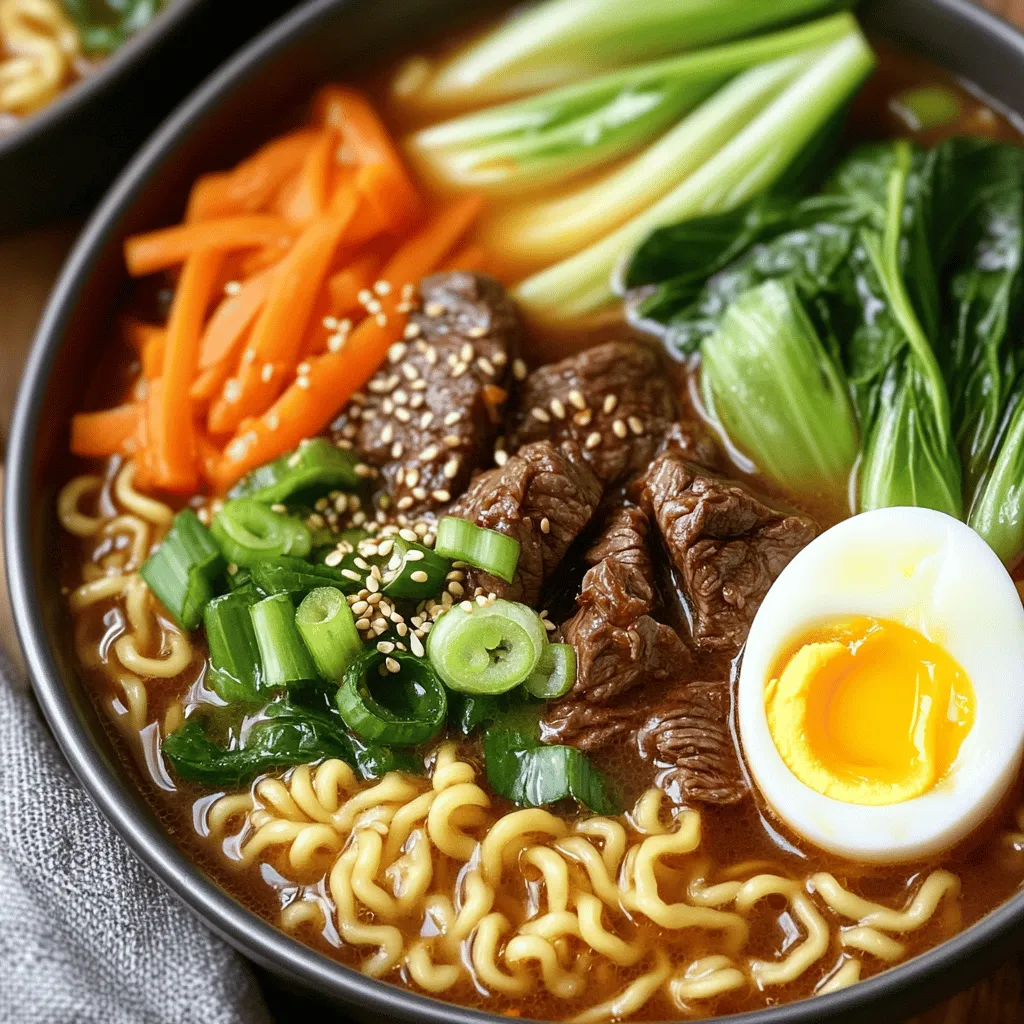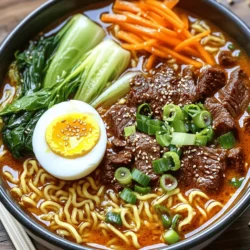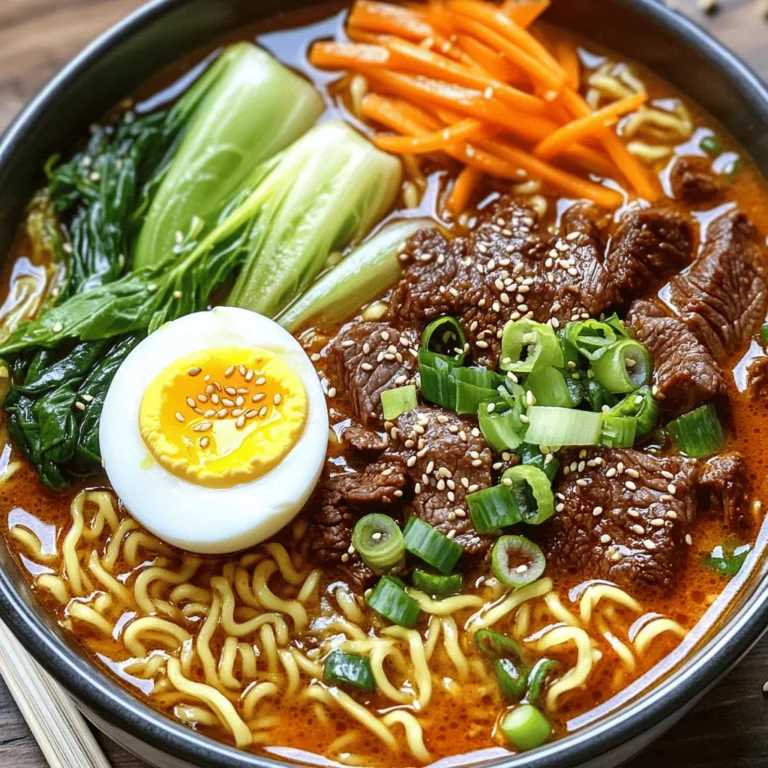Get ready to spice up your dinner with Spicy Korean Beef Ramen! This dish bursts with flavor from tender beef, savory broth, and fresh veggies. You’ll love how quick and easy it is to make. In just a few steps, you can create a delicious meal that warms your soul. Let’s dive into the simple ingredients and step-by-step instructions to satisfy your cravings!
Ingredients
Main Ingredients
- 200g ramen noodles
- 200g beef sirloin, thinly sliced
- 2 tablespoons gochujang (Korean chili paste)
Broth Ingredients
- 3 cups beef broth
- 1 tablespoon sesame oil
- 1 tablespoon brown sugar
Vegetables and Garnish
- 1 cup bok choy or spinach
- 1 medium carrot, julienned
- 1 soft-boiled egg (optional)
When preparing your Spicy Korean Beef Ramen, start with the right ingredients. The ramen noodles form the base. Use fresh ones for the best texture. Thinly sliced beef sirloin adds rich flavor and protein. Gochujang gives the dish its signature heat and depth.
For the broth, beef broth creates a hearty base. Sesame oil adds nuttiness. Brown sugar balances the spice with sweetness. Fresh vegetables like bok choy or spinach add color and nutrition. Carrots provide crunch and natural sweetness. A soft-boiled egg on top makes it feel special.
Gather these ingredients, and you’re ready to create a flavorful meal. Each element plays a part in making this dish truly delightful.
Step-by-Step Instructions
Marinating the Beef
To start, get a bowl and add your thinly sliced beef. Then, mix in 2 tablespoons of gochujang, 1 tablespoon of soy sauce, 2 minced garlic cloves, and 1 inch of grated ginger. This spicy blend adds great flavor. Let the beef sit for at least 15 minutes. This helps the meat soak up all those tasty flavors.
Preparing the Broth
In a large pot over medium heat, mix 3 cups of beef broth, 1 tablespoon of sesame oil, 1 tablespoon of brown sugar, and the white parts of 2 chopped green onions. Stir well and let it simmer gently. This broth will be the heart of your ramen, so make sure it’s flavorful.
Cooking the Beef and Noodles
Next, heat a small amount of oil in a separate pan over high heat. Add the marinated beef and stir-fry it until it turns brown and is cooked through. This should take about 3 to 4 minutes. Remove the beef from heat when done. In the pot with your broth, add 200g of ramen noodles. Cook them according to the package instructions, usually about 4 to 5 minutes.
Adding Vegetables
In the last minute of cooking the noodles, toss in 1 cup of bok choy (or spinach) and 1 julienned carrot. This step adds color and nutrition to your ramen. Allow the vegetables to wilt into the hot broth for that perfect touch.
Assembling and Serving
Now, it’s time to serve! Divide the cooked noodles and vegetables into bowls. Pour the hot broth over everything. Top each bowl with the cooked beef. You can also add a soft-boiled egg, chopped green onion tops, and a sprinkle of sesame seeds. This makes your dish look and taste amazing!
Tips & Tricks
Perfecting the Broth
To make the broth just right, you can adjust the spiciness with gochujang. If you want it hotter, add a bit more gochujang. For a milder taste, use less. Taste as you go. This way, you can find the perfect balance for your palate.
Noodle Cooking Tips
Getting the ramen noodles just right is key. Follow the package instructions closely. Usually, it takes about 4-5 minutes. Stir gently to keep them from sticking together. Once cooked, drain them quickly to avoid mushiness.
Garnishing for Presentation
Garnish adds beauty and flavor. Top your ramen with a soft-boiled egg for richness. The egg can be halved for a nice presentation. Sprinkle chopped green onions and sesame seeds on top for color and crunch. Serve in deep bowls to catch all the broth and allow for easy slurping. A drizzle of sesame oil adds shine and flavor too!

Variations
Protein Alternatives
You can change the beef in this recipe. Chicken, pork, or tofu work well. Just cut them into thin strips. For chicken, use breast or thigh meat. For pork, choose tender cuts like loin or belly. Tofu gives a nice plant-based option. Press it to remove extra water for the best texture.
Customizing Spice Levels
Want more heat? Add extra gochujang. If you prefer less spice, reduce the amount. You can also add some sugar to balance the heat. Try adding a splash of lime juice for a bright flavor. Always taste as you go to find your perfect level.
Different Vegetables
Feel free to mix in your favorite veggies. Seasonal options include zucchini, bell peppers, or mushrooms. Add them in the last minute of cooking. This keeps them crisp and colorful. You can also use frozen veggies if fresh ones aren’t available. They work great too!
Storage Info
Storing Leftovers
After enjoying your Spicy Korean Beef Ramen, you may have some leftovers. Store them in an airtight container. Place the beef, noodles, and broth together. Keep the veggies separate to stay fresh. Refrigerate for up to three days. When you want to eat, reheat in a pot. You can add a splash of broth to make it hot and tasty again.
Freezing Options
Want to save some for later? You can freeze this ramen! First, let it cool down completely. Then, put the noodles and broth in a freezer-safe container. It’s best to freeze the beef and veggies separately. This helps keep their taste and texture. When you’re ready to eat, thaw everything in the fridge overnight. Reheat gently on the stove, adding a little water if needed.
Shelf Life
Once you cook the ramen, the freshness of ingredients matters. The broth lasts about three days in the fridge. The beef is best eaten within three days too. Cooked veggies can last about two days. Always check for signs of spoilage before eating. If it looks bad or smells off, toss it out. Keeping track of these time frames will help you enjoy your ramen safely.
FAQs
What is the best type of ramen noodles to use?
For this Spicy Korean Beef Ramen, I recommend fresh or dried ramen noodles. Fresh noodles cook fast and taste great. Dried noodles are also fine, just follow the package instructions. Make sure they are egg noodles for a richer flavor. You can also try instant ramen, but the taste may not be as good.
Can I make this dish ahead of time?
Yes, you can prepare some parts ahead of time. Marinate the beef a few hours before cooking. You can also cook the broth and store it in the fridge. Just reheat it when you are ready to eat. Cook the noodles fresh when serving for the best texture.
How spicy is this Spicy Korean Beef Ramen?
The spiciness comes from gochujang, which gives a nice kick. If you like it less spicy, use less gochujang. You can also add sugar to balance the heat. If you want it spicier, add more gochujang or some chili flakes. Adjust it to fit your taste.
Can I substitute gochujang with another ingredient?
If you don’t have gochujang, you can use sriracha or chili paste. Mix these with a little sugar to mimic the sweet and spicy flavor of gochujang. It won’t taste the same, but it will still be delicious.
In this post, we explored how to make Spicy Korean Beef Ramen from scratch. We covered the key ingredients, from beef and ramen to flavorful broth and fresh vegetables. I shared step-by-step instructions to ensure your meal turns out delicious. You can adjust spice levels to fit your taste and use different proteins or veggies for variety. Finally, I provided tips on storing leftovers and answered common questions. Enjoy creating your own tasty ramen, tailored just for you!


